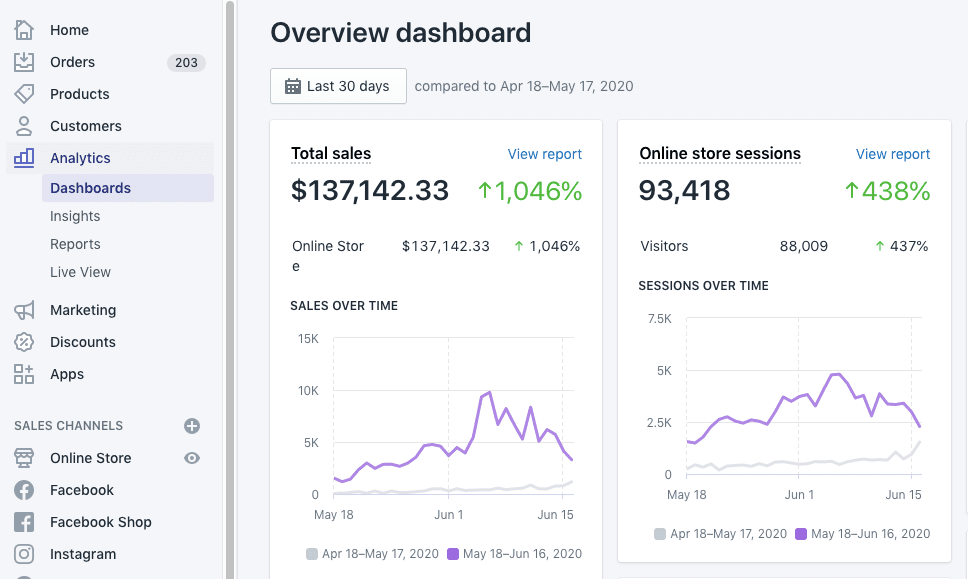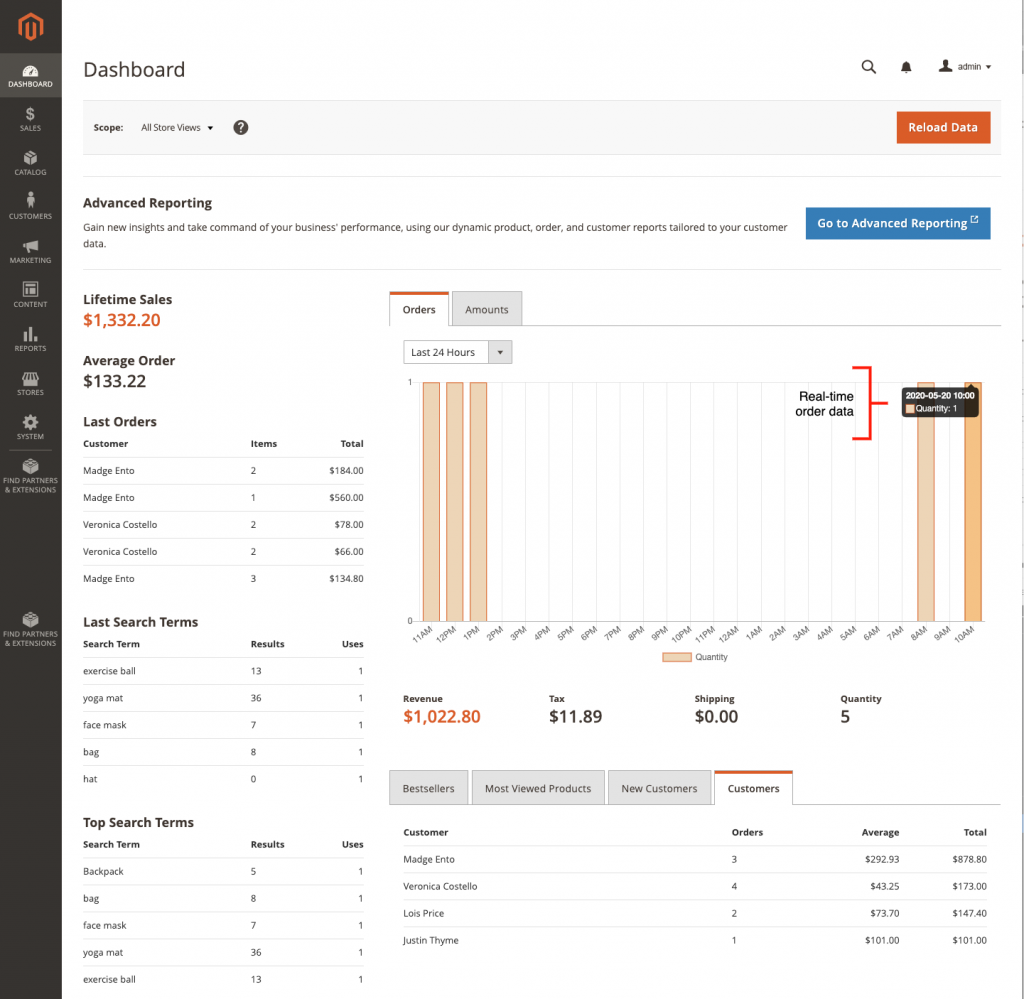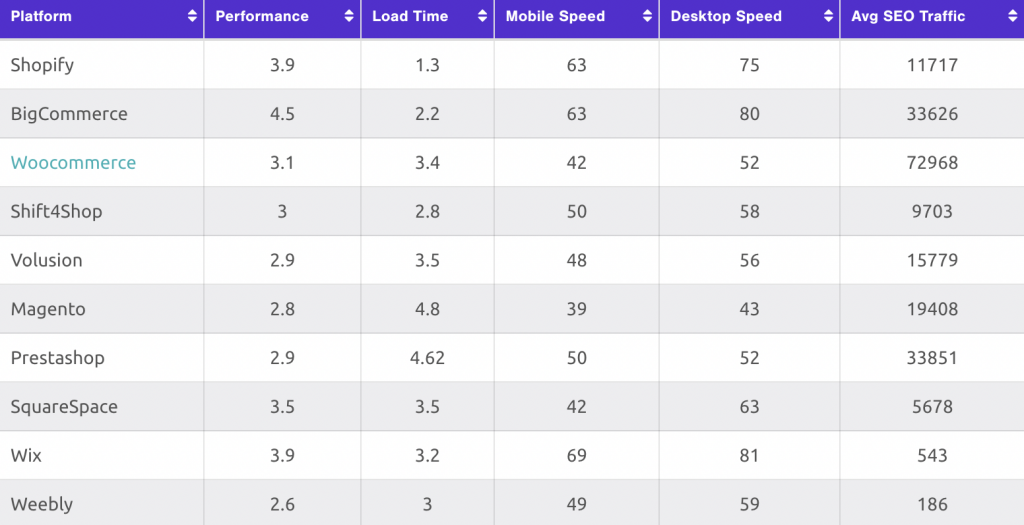Anyone planning to launch the ecommerce website eventually runs into the challenge of choosing between Adobe Commerce (Magento) vs Shopify. These two most popular ecommerce platforms are both used by big brands and have established themselves as experts in the market:
- Stats on Shopify usage: The platform hosts the websites of over 4 million merchants, including such brands as PepsiCo, Heinz, RedBull, The New York Times, BBC, etc. The solution is used in 175 countries, with the majority of domains (around 70%) enrolled in the US.
- Stats on Adobe Commerce (formerly Magento) usage: As of November 2022, Magento has over 168,000 active users and accounts for some big international corporations such as Nike, Ford, Lenovo, Nestle, Hermès, Olympus, etc.
But the figures do not necessarily mean that one platform is better than another. Right?
In this article, you’ll find a complete Magento vs Shopify comparison guide with the peculiarities of both platforms, their pros and cons for each business, and pricing models. Read on to see what makes Shopify different from Magento and which platform suits you best!
This article is based on Elogic expertise developing 100+ ecommerce projects over the past 10 years.
Note: Adobe acquired Magento in June 2018 and added it as an commerce solution to its Adobe Experience Cloud. For the sake of consistency, the terms Magento and Adobe Commerce will be used interchangeably in this article.
Adobe Commerce vs Shopify Overview: What’s the Difference Between Shopify and Magento?
If you’re pressed on time, here is a brief overview of both platforms so that you can grasp the main differences between Adobe Magento vs Shopify.
| Adobe Commerce (aka Magento) | Shopify | |
| Launched in | 2015 | 2004 |
| Ease of use | Complex | Easy |
| Source code accessible | Open-source | Proprietary source |
| Hosting | On-site, third-party, Cloud-based | Cloud-based |
| Extensions | 4,600+ | 4,000+ |
| Cost | Free and premium editions | From $29 |
| Features | Feature-rich | Feature-rich |
| Ease of Integration | Flexible | Limited to Shopify API |
| Theme selection | 12 from the official marketplace and thousands of community-created themes | 60+ |
| Payment Gateways | Has 3 built-in payment gateways and supports fast API-led integration of any third-party payment method. | Supports 70+ payment gateways and charges an extra fee for payments via third-party providers |
| Security | Advanced security and regular updates | SSL certificate included |
| Multilingual capabilities | Built-in multi-lingual support. | It does not provide full multilingual capabilities. Third-party apps can be integrated for multi-lingual support. |
| Product Variants | Unlimited | Limited to 100 |
| Available Devices | Windows, Android, iPhone/iPad, Mac, Web-based | Windows, Android, iPhone/iPad, Mac, Web-based |
| Ideal Ecommerce Size | A large enterprise with lots of resources | Small companies wanting to go online |
In a nutshell, both platforms target different merchants. Shopify is a great fit for small businesses; once you grow bigger, you might be pressed to upgrade to Shopify Plus which is recommended for high-volume enterprises.
Meanwhile, Adobe Commerce should be a perfect fit for medium-sized businesses and large enterprises. It offers richer, more powerful functionality and more customization freedom, which is why Magento is best for ecommerce.
Here are five most striking differences between both platforms:
- SaaS vs open-source: Shopify is a hosted SaaS platform which is easier to manage but leaves you less control over your store functionalities. Magento is an open-source solution which is more complicated to manage but more customizable.
- Products: on Shopify, you’ll be able to sell only one physical type of product. Adobe Commerce offers six product types (simple, configurable, virtual, group, bundle, and downloadable products), which suit more complex business types and use cases.
- B2B & wholesale features: Adobe Commerce has a built-in module with advanced Magento B2B features like tiered pricing, custom catalogs, different customer groups, etc. In Shopify, you’ll need to extend your store functionality with a custom add-on.
- International commerce: You can open multiple stores in Magento, localize them in different languages, apply different tax and pricing rules, etc. Shopify will be a better option for local merchants selling in one region.
- Security: Shopify offers PCI compliance and security upgrades out-of-the-box. Meanwhile, with Magento, you should be really careful about the code you write and the patches you install, which might be the cause of security vulnerabilities.
Now let’s move forward to a more in-depth analysis of both platforms that will help you decide which one is better. You might also want to check out more reviews of Magento compared with other ecommerce platforms on our blog:
Shopify vs Magento Comparison
So far, we have scratched the surface but let’s dive in just a little bit deeper into all peculiarities. In this section, we compare twelve essential characteristics of both solutions, such as ease of use, features, SEO, costs, and others.
It is obvious that one solution is better at something but worse at something else. Therefore, we suggest creating a priority list (and preferably organizing it into a website specification document). This way, you will understand what are the most important platform characteristics for you and which ones can be compromised.
Pricing
Pricing is one of the biggest concerns for merchants who budget for an ecommerce website. After all, you want to make sure you get the right value for the money you invest.
Shopify pricing is quite straightforward: there are three plans with fixed monthly prices:

These don’t include the additional costs for design themes, plugins, and payment processing fees outside Shopify Payments. A merchant can take advantage of a free 14-day trial period to see how Shopify works in practice.
Adobe Commerce costs are a bit more difficult to explain: pricing plans depend on your average gross sale revenue. Magento 2 Open Source comes for free, but then you will need to set up your store all alone. If you’re not much of a techie, you should consider the costs of web development, design, hosting, etc. Adobe Commerce pricing starts at $22,000+/year and includes more features and cloud hosting, which means you might save on development services.
Learn more about Magento pricing plans here.
Features
The best platform for your business is defined by the number of native features it offers. After all, if they meet functional requirements for your ecommerce website, you’ll save a pretty penny on extensions and custom development. Let’s see what Shopify vs Magento have to offer.
Shopify presents a basic set of features for ecommerce management. While large-scale retailers will consider it rather limited, small businesses may actually find it a kind of a blessing: merchants can manage all the business operations without feeling overwhelmed with the unnecessary functionality.
Here are the features that a Shopify Basic plan offers to their merchants:
- Storefront: access over 70 customizable mobile-friendly themes, plus a domain name
- Shopping cart: get a free SSL certificate, manage shipping rates, launch effective email marketing campaigns to reduce cart abandonment rates, install payment gateways, etc.
- Store management: create orders manually and manage customer accounts, returns, and refunds
- Marketing and SEO: benefit from the automatically generated sitemap, customizable H1, discounts, social media integrations
- Products: add unlimited products to your store, track inventory, and sell across multiple locations
- Analytics: access a variety of reports to track and analyze your store’s performance
Keep in mind that various Shopify plans offer different features. For example, ecommerce automations are not available in the Basic plan, so you’ll need to pay extra if you need them. Learn more about the feature set of each Shopify plan here.
Adobe Commerce outruns Shopify in terms of features and can meet any business need of a mid-size business or enterprise. On top of the basics, you get:
- Omnichannel commerce features: add multiple storefronts, use integrated B2B functionality, and manage your sales channels with ease.
- Store management: customize user experience (UX), personalize your product pages, use AI-powered search tool, and manage customer accounts
- Mobile-first design: create mobile-first solutions and take advantage of the PWA studio to create your own shopping app
- Analytics: analyze customer insights with built-in business intelligence (BI) and get reports on your store performance
- Performance and security: use built-in tools to secure and speed up your website.
The feature set is defined by the edition as well. Magento Open Source will have fewer features than its cloud-hosted Adobe Commerce edition but might even expand all the features of Shopify in the upgraded editions.
For instance, manufacturers and distributors will find a coveted B2B module in Magento Commerce and Commerce Cloud editions. They won’t be able to sell B2B with Shopify but rather will have to move to Shopify Plus to access the B2B module.
Ease of use
The ease of use will define how many people you need to build and manage the eCommerce platform and whether you will be able to fully use the potential of the solution.
Shopify has always been praised for its ease of use. The platform allows you to create a website without having to deal with programming languages and long lines of code. A clean, intuitive interface offers drag-and-drop tools for basic customization.
Still, the ease of use comes at the cost of deeper customizations and flexibility of third-party system integrations. If Shopify marketplace extensions aren’t enough, you’ll need to hire a Shopify developer to build custom features and bypass the closed Shopify system.
Once your Shopify website is up and running, you can easily understand the admin board with analytics, orders, products, etc. Every section offers an explanation once you click on it. Basically, that’s everything a beginner merchant is looking for!

Adobe Commerce will require more coding skills or dedicated Magento developers on the team. The more custom you go, the more code you will need to write for your website; and further management of the store will have a pretty steep learning curve.
Still, the platform’s need to code is one of its biggest strengths. Magento is an open-source platform, which opens unlimited potential for customization. You can play around with the code and build beautiful shopping experiences in a scalable API-led ecommerce architecture.

Theme selection
Stanford Persuasive Technology Lab discovered that 46% of people consider a website design to be the top factor determining the credibility of the business. Let’s take a look at how well Adobe Commerce or Shopify live up to these expectations in terms of theme selection.
Shopify offers 9 free and 72 premium themes priced between $150 and $350. Some more Shopify design templates can be found on community-created websites like ThemeForest or TemplateMonster. You can customize them to a certain extent with a Shopify consultant by your side, but don’t expect to change much at the code level.

Adobe Commerce offers about 12 themes on Magento marketplace that will cost you between $30 and $499. Still, the very nature of the platform suggests that you build your UI/UX design from scratch. Sure, you can download the pre-built template in case you’re looking for an easy way out; however, designing your own theme will give your store a unique look and feel and align your store features with a buyer’s journey.
Check out a sleek design of Glassmania, a Swiss glass producer and Elogic client, who has managed to enhance the user experience as well as optimize the website for future growth.

Note: Customizing UI/UX design on both Shopify and Adobe Commerce might eventually cost you all the same. The only difference is that it will be much easier on Magento, and you can budget for it at the early stage of project development. Theme customization on Shopify is possible but might cause many problems during software updates. Plus, it’ll take much longer to implement, which results in unpredicted overhead development costs.
Apps and add-ons
Add-ons define how much you can extend a website’s functionality: there are tools for SEO, email marketing, upselling and cross-selling, tip sections, etc. However, keep in mind that the more you add, the slower your website becomes.
Shopify offers 4,000 plugins and 1,500 of them are free to use. All of the plugins are easy to integrate, and you won’t need to involve the tech team for this purpose.
Adobe Commerce has 4,600 add-ons with all kinds of the needed functionality. You might need help from IT professionals in order to integrate add-ons on Magento. You can also consider Magento custom extension development if you can’t find the needed feature.
Payment methods
One way to create a superior checkout experience is to offer your shoppers multiple payment options. Yet, you don’t want to lose much on online payment gateway fees either, so it’s always better to have an ecommerce platform that has payment methods integrated for you.
There are two ways in which Shopify merchants can accept payments on their websites: Shopify Payments of third-party payment gateways. In the case of Shopify Payments, you’re automatically set up to accept such payment methods as mobile wallets, Amazon Pay, and some major credit cards (Visa, Mastercard, and American Express). You won’t be charged any third-party transaction fees, while credit card fees will depend on your Shopify plan:
| Basic Shopify | Shopify | Advanced Shopify | |
| Transaction fee if not using Shopify Payments | 2.0% | 1.0% | 0.5% |
| Online credit card rates | 2.9% + 30¢ USD | 2.6% + 30¢ USD | 2.4% + 30¢ USD |
Keep in mind: Shopify Payments is only available to stores located in certain countries. If you don’t find your region on the list or if you need to add a payment method that isn’t provided by Shopify out-of-the-box (such as cash on delivery or pay in installments), you’ll need to integrate a third-party service and consider their transaction fees.
Adobe Commerce on the other hand offers both offline and online payment gateways out of the box. You can accept check and credit card payments, bank transfers, cash on delivery, and zero subtotal checkout. Besides the native PayPal, Amazon Pay, Braintree, Authorize.net, and Klarna, you can still add whatever Magento payment gateway you like without extra fees.
One of the things that Adobe Commerce offers is paying for virtual products and subscriptions. Our client, Saudi Coffee Roasters, actually replatformed from Shopify to Magento for this exact reason. The brand wanted to offer their customers online and offline workshops that could be paid online — something that we successfully implemented on Magento, but not on Shopify.
SEO
SEO is essential for ecommerce. At least 43% of eCommerce traffic comes from Google organic search, so it’s important that your platform can place you on the first page of SERP.
Read also: Using machine learning (ML) in ecommerce
Unfortunately, the SEO toolbox is one of the biggest weaknesses of Shopify. The platform allows you to add meta tags, edit the website structure, play around with keywords and alt text, or hide a page from search robots. However, you won’t be able to change the URL structure or reduce web page load speed, which may become a problem after you add many plugins.
Keep in mind: There are certain ways to bypass the Shopify SEO limitations. Reach out to us for a personalized Shopify consultation and have your questions asked at all times.
In Adobe Commerce, you can access a richer set of features. On top of the basics, you can also use best Magento SEO practices: canonical tags, redirects, URL edits, optimize descriptions, etc. Also, access to the source code will allow you to optimize it and help the Google bots crawl your pages faster. The Varnish caches more requests for large-scale projects, and the PHP7 and MySQL5.6 produce a faster page load from the server.
Speed and performance
It’s no secret that page load speed affects conversion rates. After all, no user wants to wait for 10 seconds for a page to load, let alone browse product catalogs or place an order. Let’s see how Shopify compares against Adobe Commerce in terms of speed and performance.
As any other SaaS platform, Shopify is a fully-hosted solution that takes care of your website performance and speed optimization. Some research suggests that Shopify stores usually have a faster loading time of 1.3 seconds. However, this page load speed is achieved only with a limited number of SKUs and plugins added to your store.
If you operate a small store, your Shopify performance will be stellar; but as soon as you start scaling, you might be pressed to upgrade to Shopify Plus or change the platform overall.
Adobe Commerce merchants are fully responsible for handling the performance. For some non-techie retailers, Magento websites will be slower than those of Shopify and can take more time to load. However, with the right Magento hosting provider, the website speed is entirely in your hands.
For instance, an Aussie fashion retailer, Whola, was about to replatform before they came across Magento performance optimization services at Elogic. We optimized their store performance fivefold by configuring their server environment and conducting a custom code audit.
Keep in mind: the more complex your website gets, the more time it needs to get loaded. And you can still fix it if you want. Whereas in Shopify, you just hope that someone else fixes things for you.

Scalability and flexibility
It’s important to choose the eCommerce solution that would be able to satisfy your long-term business goals.
With Shopify, to scale means to upgrade to a more expensive pricing plan. Shopify Advanced will give you the widest variety of features to expand your store at a fee of $299 per month. Yet, with Shopify scalability, prepare to see constantly growing payment transaction fees (especially for international payments) and limit your business to 8 storefronts (the max supported in Shopify).
Read more: Migrate Shopify to Magento: We Have All the Answers
The same goes for flexibility. Unless your growth plans include selling overseas, launching subscriptions, or offering highly configurable products, Shopify might be the right choice for you.
Being an open-source platform, Adobe Commerce has no limits in terms of scalability. The platform can sustain 10 million SKUs without sacrificing your store performance, and its layered architecture consists of various layers that scale independently depending on your business use cases and system loads.
You might still need to take care of the hosting environment or hire dedicated Magento professionals to do it for you. They’ll also customize your store to any extent and leverage the platform’s built-in features to achieve maximum scalability.
Security
Data breaches can significantly damage your reputation: over a third of consumers report that they would stop shopping with a brand that has suffered a breach.
Shopify takes care of security issues all alone: all patches and certificates are installed by Shopify’s team. The platform is PCI compliant and provides SSL encryption to manage customers’ confidential information. But keep in mind that Shopify is a hosted platform, so security maintenance is monitored for you. If you need more advanced protection, you will not be able to do anything on your own, unfortunately.
Adobe Commerce takes numerous security measures to ensure the maximum protection for its users. Magento 2 has introduced sophisticated approaches to preventing cross-site scripting (XSS) attacks and clickjacking exploits. The vendor also analyzes their system for any potential vulnerabilities and issues security patches every quarter to secure the merchants.
Support
There’s almost no way to avoid technical issues with your store, so consider whether the solution provides the needed support services.
Shopify offers 24/7 support and you can contact them via chat, email, or phone. Basically, the support is there because you can do nothing from your side if there are problems with the system.
Only Adobe Commerce offers the option of managed services. The free edition of Magento Open Source doesn’t provide any customer support; however, you can access multiple video tutorials, fora, and DevDocs. You can also submit support tickets to the Magento Help Center if any technical issues arise, although it may take a while for them to respond.
To stay on the safe side, you may consider hiring a dedicated agency that would provide Magento support services fully tailored to your unique business needs.
What Is Better for You: Shopify or Magento?
In a nutshell, there’s no way of saying that one platform is better than the other. Both Adobe Commerce and Shopify target different merchants and serve varying business needs.
Shopify is great for small retailers or dropshippers looking to establish an online presence. You don’t need to have extensive technical knowledge or resources to hire a tech team; rather, you can purchase any Shopify plan and start selling ASAP.
If you value ease of use, automatic maintenance and security, and ease of integration and don’t plan to expand your business in the near future, Shopify will be more than enough.
Adobe Commerce (Magento) is much more powerful yet much more complex. It is the best fit for mid-sized companies and enterprises which require advanced functionality and a high level of customization. Such merchants can afford a development team, seek extensive scalability and flexibility, and are ready to take care of maintenance, performance, and security issues on their own.
Established business owners planning to scale and expecting huge website traffic volumes will find Magento a perfect ecommerce solution.
Contact us and we’ll help you choose the best platform for your business.
I want my free consultationMagento vs Shopify FAQ
What are the pros and cons of Shopify versus Magento?
Shopify is an easy-to-use platform that offers all the needed eCommerce plugging and 24/7 customer support. On the other hand, it has limited customization features and a poor contact management system.
Magento has lots of customization options, which give you full control over the website’s functionality and lots of potential for scaling your business. On the other hand, Magento Commerce pricing starts at $1,833 per month which is quite costly. Moreover, using Magento requires the involvement of an IT team.
Why is Magento better than Shopify?
Magento offers more opportunities for customization, scalability, and feature expansion than Shopify. You can also create add-ons on your own and add as many payment gateways as you like without extra fees. With Magento, you have endless control over your website maintenance, performance, and security.
Can Magento and Shopify be used together?
Yes. Even though these are different ecommerce platforms, Magento Shopify integration is possible using pre-built and custom connectors. You can connect multiple Shopify accounts and exchange data with Magento. Reach out to us at Elogic if you need to connect your Adobe Commerce and Shopify stores.
Is Shopify open source?
No, Shopify isn’t open source. It is a subscription-based SaaS platform that is hosted and managed for a retailer.
Why do companies choose Shopify?
Small businesses find Shopify attractive for its ease of use and managed services. If you want to establish an online presence, have few SKUs in your catalog, and have no coding experience whatsoever, Shopify serves as a great start for an ecommerce business.
Magento vs Shopify FAQ
What are the pros and cons of Shopify versus Magento?
Shopify is an easy-to-use platform that offers all the needed eCommerce plugging and 24/7 customer support. On the other hand, it has limited customization features and a poor contact management system.
Magento has lots of customization options, which give you full control over the website’s functionality and lots of potential for scaling your business. On the other hand, Magento Commerce pricing starts at $1,833 per month which is quite costly. Moreover, using Magento requires the involvement of an IT team.
Why is Magento better than Shopify?
Magento offers more opportunities for customization, scalability, and feature expansion than Shopify. You can also create add-ons on your own and add as many payment gateways as you like without extra fees. With Magento, you have endless control over your website maintenance, performance, and security.
Can Magento and Shopify be used together?
Yes. Even though these are different ecommerce platforms, Magento Shopify integration is possible using pre-built and custom connectors. You can connect multiple Shopify accounts and exchange data with Magento. Reach out to us at Elogic if you need to connect your Adobe Commerce and Shopify stores.
Is Shopify open source?
No, Shopify isn’t open source. It is a subscription-based SaaS platform that is hosted and managed for a retailer.
Why do companies choose Shopify?
Small businesses find Shopify attractive for its ease of use and managed services. If you want to establish an online presence, have few SKUs in your catalog, and have no coding experience whatsoever, Shopify serves as a great start for an ecommerce business.


